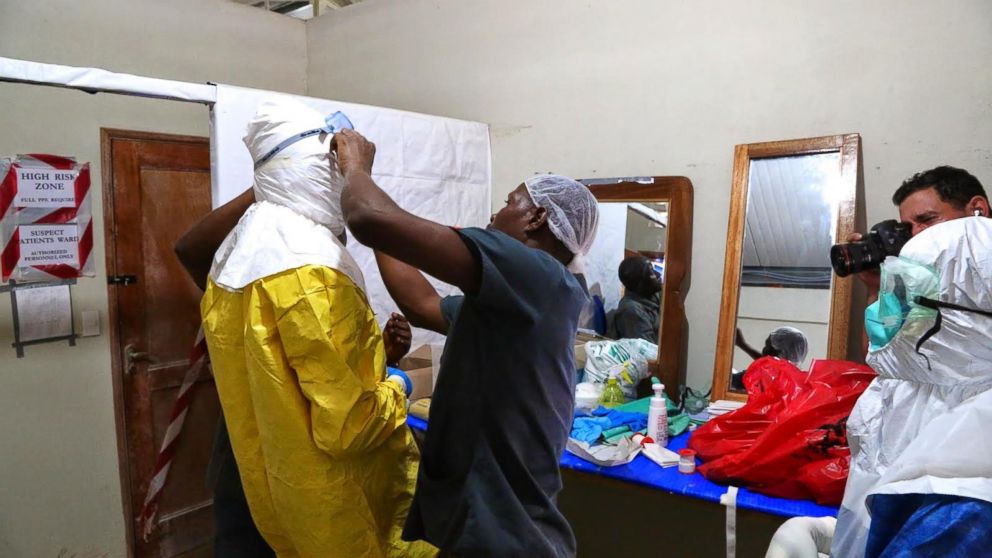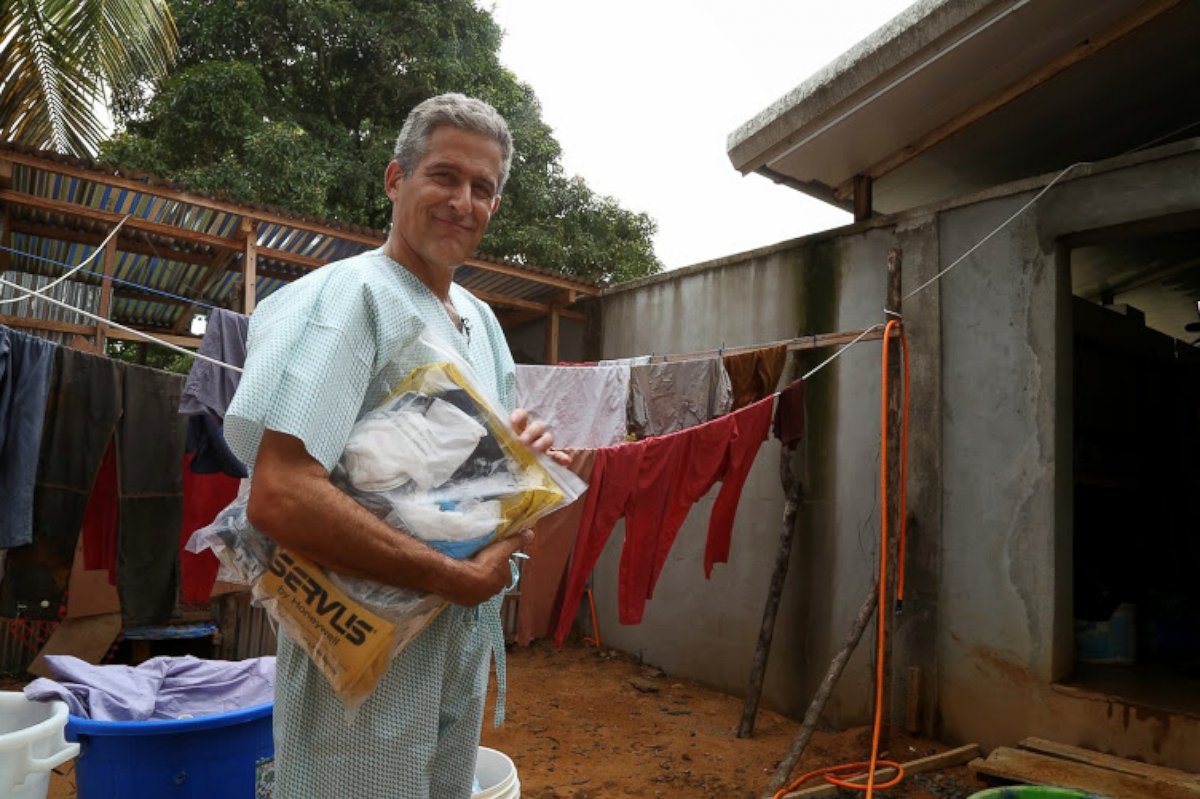Face-to-Face With Patients in the Ebola Ward
Dr. Besser became the first journalist to step inside the ELWA2 Ebola ward.
MONROVIA, Liberia — -- "Before we enter the Ebola ward, we pray," Dr. Jerry Brown tells me as we stand just outside the second-oldest Ebola treatment unit in Monrovia, clad in layer after layer of protective gear.
I’m about to become the first journalist allowed inside. My head tells me we’re safe, but my heart is pounding.
For information on how you can help, click here.
A few minutes earlier, three people watched and made adjustments as I put on scrubs, boots, a pair of gloves, foot covers, a full-body Tyvek suit, a second pair of gloves, a respirator mask, a second hood, goggles, a third pair of gloves and a heavy, yellow apron. Not a speck of skin is exposed to the air. After just five minutes in this cocoon, I am saturated in sweat.
My producer hands me two GoPro cameras, and I follow Brown inside to see his patients. Although the ward was designed to hold 40 people, I’m told there are 60 patients here today.
“When you leave the clinic and see people lying on the ground, sick with Ebola and wanting help, how can you say no?” a doctor who works with Brown told me. “We make room.”
A Family's Struggle to Overcome the Ebola Virus in Liberia
Dr. Besser Chats With Relief Workers Headed to Ebola Hot Zone
Dr. Besser Gets Tips Before Heading to Ebola Hot Zone
Our first stop is the area designated for suspected Ebola cases. These people have symptoms consistent with Ebola and exposure to a known Ebola patient, but they have not yet been tested.
Children mix in with adults. Some of the patients are in individual patient bays divided by canvas walls. Others are in the main room, an open area containing no more than 10 cots. I notice one major infection control issue: there is only one toilet, and everyone shares it. This is problematic because Ebola is spread through direct contact with bodily fluids. But it’s all they have to work with.
Brown makes his rounds, asking everyone how they are doing. If I saw some of these patients in my office, I wouldn't think they were sick. Others look near death.
Loud music blares over the radio. "I want them to have some entertainment," Brown explains.

I am struck by how frightening it must be for these patients, especially the children. To them, we are coming toward them in space suits with only our eyes visible to show we’re human. I focus on trying to smile with my eyes for each child I see.
We round a corner and move into the area with confirmed Ebola patients. The first two are out in the corridor under an awning. One man looks deathly ill. Dehydration from the diarrhea, Brown tells me.
Inside the main ward, there are more than a dozen patients. In a corner, I see 10-year-old Richmond, wearing an American shirt with “Wisconsin” written across the front. I catch myself before I ask him if he's ever been there. Contaminated clothes are taken away from each patient when they enter the ward. He got that shirt as a replacement when he arrived.
I ask how he's doing. He looks good.
"Fine," he says. "My chest hurts."
His mother tells us that he coughed up blood that morning, a very bad sign for someone with Ebola. Brown will keep a close eye on him.
Next, we stop by a single room no bigger than a closet to check on a 26-year-old man. He says he caught Ebola sharing a room with a man who had a fever. The man was tested for malaria and then typhoid fever. By the time he was tested for Ebola, he had infected his roommate.
As we move into the main common room, I’m caught off guard. A flat screen TV hangs on the wall and 15 or so Ebola patients sit watching it, clearly no longer ill. Since the ward won’t release patients until they undergo a negative Ebola test administered after two days of showing no symptoms, patients need something to do as they get better. On average, it takes about 10 days between when the patient arrives and when they test negative for Ebola. This room reminds me more of a community center than a ward for the deadliest disease on the planet.
Down the hall, I see many rooms with sicker patients: a nurse who'd been bleeding, a young man with anemia. Brown said he gave them blood transfusions.
"We can't match blood types here so we give everyone O-positive." He said, adding that the blood came from Ebola survivors -- the same treatment given to Dr. Rick Sacra, the American Ebola patient treated in Nebraska. The blood had been tested to make sure it didn't have HIV or hepatitis B.
Then, Brown explains one of the most amazing things about the unit. There were many health workers treated there, so as they started to improve, he put them to work. They became his monitoring system.
He gave instructions to a recovering nurse as we entered the room.
"I've just started blood transfusions on two patients,” he said. “Keep an eye on them. Look at their skin. If you see a rash, borrow a cell phone and call me."
"Do I touch the skin?" the nurse asked.
"No, just look and let me know."
What a wonderful idea, making use of the skills of the patients in the unit. It's so hard to stay in the unit in protective gear. After 30 minutes, I was already worried that I was getting dehydrated. But putting recovering patients and those who have already had the virus to work solves that problem because they don’t need to wear the cumbersome gear.

After 40 minutes, I tell Brown that I should probably leave. He administers a couple IV medicines to patients, gives a big goodbye to the ward before leading me toward the exit.
Getting out of the protective suit takes even longer thank it took to put it on. Between every layer I take off, a hygienist sprays me down with bleach. Another layer, more bleach.
Stepping out into the sunlight, I feel a weight lifting off my chest. I know the feeling is more than just relief to be leaving the ward. What I saw filled me with hope. Each patient was a person first.
The unit was doing everything it could to save each life and, at least for some, it was succeeding.
Editor's Note: An earlier version of this story incorrectly stated that patients must have two negative Ebola tests administered at least 10 days apart before they can be discharged from the Ebola ward. This is not the case. They only need to undergo one negative Ebola test, which is administered after two days of showing no symptoms.




